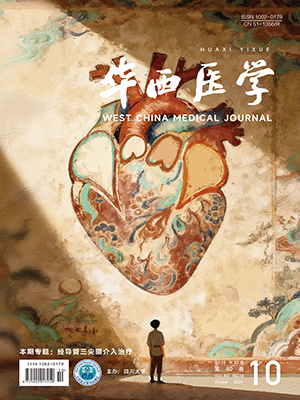| 1. |
Durr A. Autosomal dominant cerebellar ataxias: polyglutamine expansions and beyond. Lancet Neurol, 2010, 9(9): 885-894.
|
| 2. |
Maciel P, Gaspar C, DeStefano AL, et al. Correlation between CAG repeat length and clinical featuresin Machado-Joseph disease. Am J Hum Genet, 1995, 57(1): 54-61.
|
| 3. |
Ranum LP, Lundgren JK, Schut LJ, et al. Spinocerebellar ataxia type 1 and Machado-Joseph disease: incidence of CAG expansions among adult-onset ataxia patients from 311 families with dominant, recessive, or sporadic ataxia. Am J Hum Genet, 1995, 57(3): 603-608.
|
| 4. |
Gan SR, Ni W, Dong Y, et al. Population genetics and new insight into range of CAG repeats of spinocerebellar ataxia type 3 in the Han Chinese population. PLoS One, 2015, 10(8): e0134405.
|
| 5. |
范红珍, 姚文涛, 王建华, 等. 遗传性脊髓小脑共济失调 3 型 2 家系临床特征分析. 中国神经精神疾病杂志, 2018, 44(3): 186-189.
|
| 6. |
陈余雪, 李岚, 赵莉, 等. 体重指数与 IIS 系统在脊髓小脑共济失调 3 型研究中的作用. 中国神经免疫学和神经病学杂志, 2014, 21(6): 397-400.
|
| 7. |
Yang JS, Chen PP, Lin MT, et al. Association between body mass index and disease severity in Chinese spinocerebellar ataxia type 3 patients. Cerebellum, 2018, 17(4): 494-498.
|
| 8. |
Diallo A, Jacobi H, Schmitz-Hübsch T, et al. Body mass index decline is related to spinocerebellar ataxia disease progression. Mov Disord Clin Pract, 2017, 4(5): 689-697.
|
| 9. |
Gan SR, Shi SS, Wu JJ, et al. High frequency of Machado-Joseph disease identified in southeastern Chinese kindreds with spinocerebellar ataxia. BMC Med Genet, 2010, 11: 47.
|
| 10. |
Schmitz-Hübsch T, Tezenas du Montcel S, Baliko L, et al. Reliability and validity of the international cooperative ataxia rating scale: a study in 156 spinocerebellar ataxia patients. Mov Disord, 2006, 21(5): 699-704.
|
| 11. |
Guo J, Jiang Z, Biswal BB, et al. Hypothalamic atrophy, expanded CAG repeat, and low body mass index in spinocerebellar ataxia type 3. Mov Disord, 2022, 37(7): 1541-1546.
|
| 12. |
Leite CMBA, Schieferdecker MEM, Frehner C, et al. Body composition in spinocerebellar ataxia type 3 and 10 patients: comparative study with control group. Nutr Neurosci, 2020, 23(1): 49-54.
|
| 13. |
Saute JA, Silva AC, Souza GN, et al. Body mass index is inversely correlated with the expanded CAG repeat length in SCA3/MJD patients. Cerebellum, 2012, 11(3): 771-774.
|
| 14. |
Hengel H, Martus P, Faber J, et al. Characterization of lifestyle in spinocerebellar ataxia type 3 and association with disease severity. Mov Disord, 2022, 37(2): 405-410.
|
| 15. |
Russo AD, Reckziegel ER, Krum-Santos AC, et al. Clinical scales predict significant videofluoroscopic dysphagia in Machado Joseph disease patients. Mov Disord Clin Pract, 2015, 2(3): 260-266.
|
| 16. |
Rodriguez-Graña T, Rodríguez-Labrada R, Santana-Porbén S, et al. Weight loss is correlated with disease severity in spinocerebellar ataxia type 2: a cross-sectional cohort study. Nutr Neurosci, 2022, 25(8): 1747-1755.
|
| 17. |
Chiu C, Cheng W, Lin Y, et al. A pilot study: handgrip as a predictor in the disease progression of SCA3. Orphanet J Rare Dis, 2023, 18(1): 317.
|
| 18. |
Mukherjee S, Walter S, Kauwe JSK, et al. Genetically predicted body mass index and Alzheimer's disease-related phenotypes in three large samples: Mendelian randomization analyses. Alzheimers Dement, 2015, 11(12): 1439-1451.
|
| 19. |
van der Burg JMM, Gardiner SL, Ludolph AC, et al. Body weight is a robust predictor of clinical progression in Huntington disease. Ann Neurol, 2017, 82(3): 479-483.
|
| 20. |
Marin B, Desport JC, Kajeu P, et al. Alteration of nutritional status at diagnosis is a prognostic factor for survival of amyotrophic lateral sclerosis patients. J Neurol Neurosurg Psychiatry, 2011, 82(6): 628-634.
|
| 21. |
Saute JA, da Silva AC, Muller AP, et al. Serum insulin-like system alterations in patients with spinocerebellar ataxia type 3. Mov Disord, 2011, 26(4): 731-735.
|




